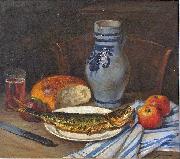
Oil On
Canvas, Real Flavor of Old Masters
|
Theo van Doesburg
|
|||
|
|
|||
| Dutch 1883-1931 Dutch painter, architect, designer and writer. He was officially registered as the son of Wilhelm Kepper and Henrietta Catharina Margadant, but he was so convinced that his mother second husband, Theodorus Doesburg, was his father that he took his name. Little is known of his early life, but he began painting naturalistic subjects c. 1899. In 1903 he began his military service, and around the same time he met his first wife, Agnita Feis, a Theosophist and poet. Between about 1908 and 1910, much influenced by the work of Honor Daumier, he produced caricatures, some of which were later published in his first book De maskers af! (1916). Also during this period he painted some Impressionist-inspired landscapes and portraits in the manner of George Hendrik Breitner. Between 1914 and 1915 the influence of Kandinsky became clear in such drawings as Streetmusic I and Streetmusic II (The Hague, Rijksdienst Beeld. Kst) and other abstract works. | |||
|
|
|||
|
|
Nature Morte new16/Theo van Doesburg-427654.jpg Painting ID:: 45003 Visit European Gallery |
mk183 Oil on canvas 82x67.5cm | |
Height Width |
INS/CM |
||
|
X |
|
||
|
|
|||
|
Georges Jansoone
|
|||
|
|
|||
| George Jamesone (or Jameson) (c. 1587-1644) was Scotland's first eminent portrait-painter. He was born in Aberdeen, where his father, Andrew Jamesone, was a stonemason. Jamesone attended the grammar school near his home on Schoolhill and is thought to have gone on to further education at Marischal College. Legend has it that Jamesone once studied under Rubens in Antwerp with Anthony van Dyck. However, this is yet to be proven as his name does not appear to be noted in the Guild registers of the town. However, considering that Rubens was exempt from registering pupils; this does not mean that the painter definitely did not study there. Jamesone certainly did complete an apprenticeship under the supervision of his uncle, John Anderson, who was a popular decorative painter in Edinburgh at the beginning of the seventeenth century. Jamesone finished this training in 1618. He is not recorded as being in Aberdeen again until 1620. If the Scotsman had gone to Antwerp, it would have had to have been between the years of 1618 to 1620. | |||
|
|
|||
|
|
Nature morte new24/Georges Jansoone-565387.jpg Painting ID:: 75642 Visit European Gallery |
Nature morte" , oil painting on canvas (50 x 60 cm) by Willem Battaille (1867-1933); private collection cyf | |
Height Width |
INS/CM |
||
|
X |
|
||
|
|
|||








